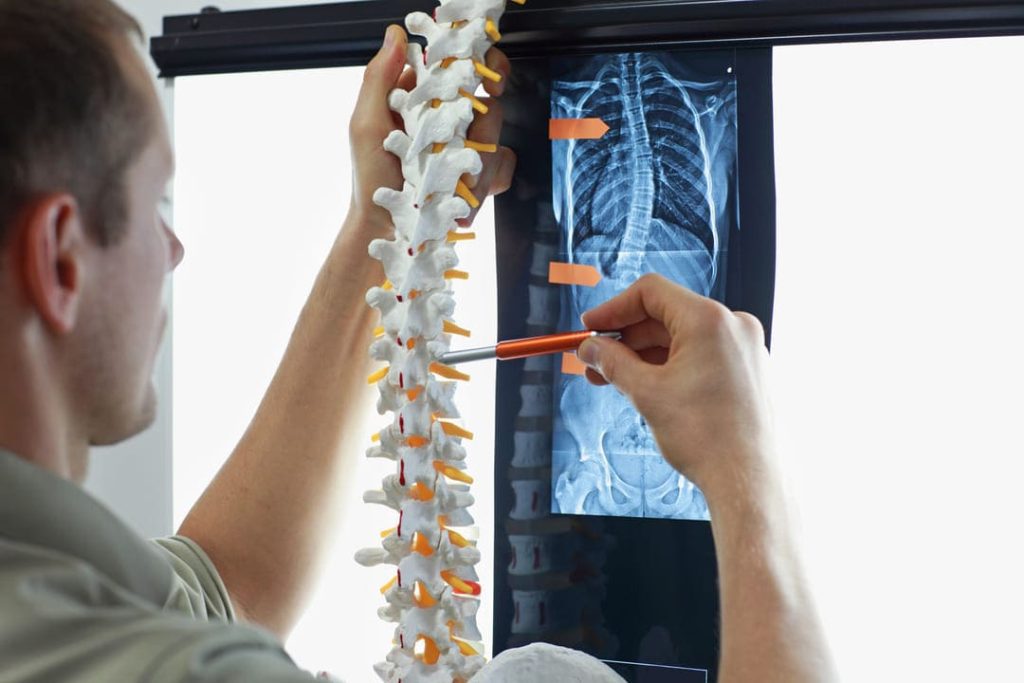Looking for Expert-Level VA Claim Answers?📱Call Us Now! 737-295-2226
Scoliosis can cause chronic pain, limited mobility, and long-term disability. If your condition began or worsened during military service—or was aggravated by heavy gear, injuries, or repeated physical strain—you may be eligible for a VA disability rating.
This guide explains scoliosis VA ratings, how to prove service connection, and how to increase your chances of getting the compensation you deserve—including VA ratings for secondary conditions like radiculopathy or intervertebral disc syndrome (IVDS).
Let’s get started.
Table of Contents
Summary of Key Points
- The VA does not rate scoliosis directly—it’s evaluated under spinal conditions based on pain, mobility, and functional limitations.
- Scoliosis VA ratings range from 0% to 100%, depending on spinal curvature severity, range of motion, and symptoms like muscle spasms or nerve issues.
- Service connection is required—you must show scoliosis was caused or aggravated by military service.
- Mild scoliosis without symptoms typically does not qualify for compensation.
- Secondary conditions such as radiculopathy, spinal stenosis, or intervertebral disc syndrome may increase your total VA rating.

What is Scoliosis?
Scoliosis is a medical condition involving spinal twisting or sideways curvature, forming a “C,” “S,” or a Z shape. It can negatively impact the thoracic (i.e., mid-back), lumbar (i.e., lower back), or both of these spinal regions. Symptoms of scoliosis may include:
- Back pain
- Side leaning of the body
- Uneven shoulder, ribs, hip, or waist
- A prominent shoulder blade in comparison to the other
- A higher hip on one side
- Jutting forward of one side of the rib cage
- Prominence on one side of the back in response to bending forward.
- Skin abnormalities over the spine (e.g., dimples, patches of hair, etc.)
- Trouble breathing in severe cases
Causes of Scoliosis
Common causes of scoliosis include:
- Certain neuromuscular conditions (e.g., cerebral palsy or muscular dystrophy).
- Congenital (i.e., occurs at birth) defects of the vertebrae (i.e., the spinal bones).
- Surgery on the chest wall during infancy
- Infections or injuries of the spine.
- Irregularities of the spinal cord
Veterans may develop scoliosis during military service, the condition may develop, or your symptoms may worsen due to:
- Physical strain
- Injuries
- Poor posture (resulting from carrying heavy gear or training exercises)
Types of Scoliosis
There are three clinical types of scoliosis, including:
- Idiopathic scoliosis is the most common type; this means the cause is unknown. Idiopathic scoliosis tends to run in families, so there’s thought to be a genetic link.
- Congenital scoliosis is an uncommon type of spinal abnormality that may be discovered at birth; it happens when your spinal bones (i.e., vertebrae) don’t form correctly during fetal development.
- Neuromuscular scoliosis involves abnormal nerves and muscles that support your spine, often accompanied by nerve or muscle conditions (e.g., muscular dystrophy or cerebral palsy).
Scoliosis VA Ratings
The VA rates scoliosis from 0% to 100% under 38 CFR § 4.71a, the General Rating Formula for Diseases and Injuries of the Spine, by analogy to the diagnostic code that best matches the anatomical location and symptomatology.
Scoliosis VA disability ratings are based on the severity of the spinal curvature, associated limitations (such as range of motion or muscle spasms), and any neurological symptoms, with or without pain.
Scoliosis VA Rating Table
| VA Rating | Criteria |
| 10% | Forward flexion of the thoracolumbar spine greater than 60 degrees but not greater than 85 degrees; or, forward flexion of the cervical spine greater than 30 degrees but not greater than 40 degrees; or, combined range of motion of the thoracolumbar spine greater than 120 degrees but not greater than 235 degrees; or, combined range of motion of the cervical spine greater than 170 degrees but not greater than 335 degrees; or, muscle spasm, guarding, or localized tenderness not resulting in abnormal gait or abnormal spinal contour; or, vertebral body fracture with loss of 50 percent or more of the height |
| 20% | Forward flexion of the thoracolumbar spine greater than 30 degrees but not greater than 60 degrees; or, forward flexion of the cervical spine greater than 15 degrees but not greater than 30 degrees; or, the combined range of motion of the thoracolumbar spine not greater than 120 degrees; or, the combined range of motion of the cervical spine not greater than 170 degrees; or, muscle spasm or guarding severe enough to result in an abnormal gait or abnormal spinal contour such as scoliosis, reversed lordosis, or abnormal kyphosis |
| 30% | Forward flexion of the cervical spine 15 degrees or less; or favorable ankylosis (of the entire cervical spine |
| 40% | Unfavorable ankylosis of the entire cervical spine; or forward flexion of the thoracolumbar spine 30 degrees or less; or favorable ankylosis of the entire thoracolumbar spine. |
| 50% | Unfavorable ankylosis of the entire thoracolumbar spine |
| 100% | Unfavorable ankylosis of the entire spine |
Kyphosis – an outward curvature of the spine causing a “hunchback” appearance
Lordosis – an inward spinal curvature, resulting in a “swayback” appearance
Ankylosis – stiffness or immobilization of a joint resulting from a disease or surgery
The thoracolumbar spine is the area between the stiff upper thoracic cage (i.e., chest area) and the lower, lumbar spine, which is considered a vulnerable area for spinal injuries.
Scoliosis VA Rating Criteria
VA disability ratings for scoliosis are assigned under different diagnostic codes under § 4.71a Schedule of ratings—musculoskeletal system, depending on the specific symptoms and severity of the condition. Common codes include 5237 (i.e., lumbosacral or cervical strain), 5239 (i.e., spondylolisthesis), 5240 (i.e., ankylosing spondylitis), and 5243 (i.e., intervertebral disc syndrome).
Getting a high VA scoliosis disability rating usually requires strong medical evidence, such as a Nexus Letter, military service treatment records, and diagnostic test results (e.g., MRIs or other imaging test results, like X-rays).
Establishing Service Connection
To establish service connection, you must prove that your scoliosis was caused or exacerbated (i.e., worsened) by your military service by:
- Providing a current scoliosis diagnosis and diagnostic test results (e.g., imaging tests, such as MRIs or X-rays)
- Showing evidence of an event, injury, illness, or exposure during military service that caused or worsened your scoliosis.
- Providing a “nexus” between your military service and scoliosis (i.e., medical evidence linking your scoliosis to an in-service event), such as a Nexus Letter.
Real-Life Example of a Medical Nexus for Scoliosis
As a combat medic, Sgt. Perez often carried a 60–80-pound rucksack over long distances. His duties included lifting and moving wounded soldiers, hauling supplies, and providing medical care in harsh terrain.
Parez’s mid and lower back pain worsened after a roadside IED knocked him off balance during an evacuation of a wounded service member. Although he was not formally diagnosed with scoliosis during his military service, his back problems were noted in his medical record.
After military discharge, Perez’s back pain progressively increased over time. His VA provider ordered an MRI that showed thoracolumbar scoliosis and signs of intervertebral disc syndrome (IVDS). His symptoms included frequent episodes of muscle spasms and sciatic pain radiating (i.e., spreading) down both legs.
Perez’s disability claim was initially denied, citing “no official diagnosis of scoliosis during military service.” He obtained a Nexus Letter from a private orthopedic specialist and filed an appeal to the initial claim’s denial. The Nexus Letter stated:
“It is at least as likely as not that Sgt. Perez’s scoliosis and intervertebral disc degeneration were caused and/or aggravated by the physical demands of his military service, including excessive load-bearing and repeated spinal strain. Medical literature (i.e., studies) supports an association between long-term load-bearing activities and progression of spinal curvature and vertebral disc damage.”
The nexus evidence included in Perez’s appeals claim included:
- Medical records, including recent scoliosis, sciatica, and IVDS diagnoses
- Service treatment records showing chronic back pain
- MRI results after military discharge
- A timeline of documented symptoms consistent with military duties
- Peer-reviewed medical research linking spinal degeneration to carrying heavy loads
SGT. Perez’s Appeal Case VA Rating Decision
After Sgt. Perez’s appeal was submitted using DC code 5243 (i.e., intervertebral disc syndrome) and DC code 8620 (i.e., sciatica), along with his medical evidence—including the Nexus Letter—he was awarded a 40% VA disability rating under DC 5243 based on medical evidence of physician-prescribed incapacitating episodes totaling at least four weeks in the past 12 months.
An additional 10% VA rating was added to Perez’s rating for radiculopathy of the lower extremities due to nerve impingement.
His combined VA rating increased to 50%, significantly improving from his initial denial.
Common Scoliosis Secondary Conditions
Common secondary conditions for scoliosis include:
- Radiculopathy (DC codes 8510, 8610, and 8710 for cervical radiculopathy, and 8520, 8620, and 8720 for lumbar radiculopathy
- Sciatica – (DC code 8620 [neuritis] or 8720 [neuralgia] depending on your symptoms) involves compression or irritation of one or more spinal nerve roots
- Intervertebral disc syndrome (DC 5243) is a breakdown or displacement of one or more intervertebral discs (i.e., the discs between the vertebrae that act as a cushion), causing neck or back. The nerve pain may radiate (i.e., spread) to the legs or arms.
- Spinal stenosis (DC 5238) – a painful condition involving narrowing of the space within the spinal canal, compressing the spinal cord and nerve roots.
- Osteoarthritis of the spine (5242) – a condition involving the breakdown of the protective cartilage in the spinal joints, leading to pain and other symptoms.
Filing a Scoliosis VA Claim
To file your VA disability claim, complete the VA Form 21-526EZ, send your application along with all supporting evidence, such as service records, medical reports, and exposure documentation, either in person at a local VA Regional Office, via the VA.gov website, or through a Veterans Service Organization (VSO).
Compensation & Pension (C&P) Exam for Scoliosis
At your C&P exam, the examiner will review your medical records, ask questions about your scoliosis symptoms, and perform a physical exam. They’ll assess your spinal range of motion—often using a goniometer—and evaluate how your condition affects your daily life and work.
The examiner will complete a Disability Benefits Questionnaire (DBQ) specific to back and spine conditions during your appointment.
Importantly, the VA is required to consider flare-ups when determining your rating. If your symptoms are worse during flare-ups than they are on the day of the exam, tell your examiner. For example, if your spine only bends to 15 degrees during flare-ups—even if you’re more flexible during the exam—that detail can support a higher rating.
Pro Tip: Review our guide on preparing for a range of motion C&P exam and learn which range-of-motion exercises may be tested.
Total Disability Based on Individual Unemployability (TDIU)
If you can’t work due to a limited range of motion or back pain, you may qualify for TDIU.
The VA offers TDIU for people with scoliosis and other back and spinal conditions that keep them from securing or following gainful employment. A TDIU pays the same as 100% disability since the VA acknowledges that your condition prevents you from working.
To qualify for TDIU, you must have:
- At least one service-connected disability rated at least 60% OR
- Two or more service-connected disabilities, with at least one disability rated at 40% or more AND
- A combined total rating of 70% or more
Wrapping Up
Living with scoliosis—especially when compounded by chronic pain or nerve damage—can significantly limit your daily function and career opportunities. If your scoliosis was caused or aggravated by your military service, you may qualify for monthly, tax-free VA compensation.
To improve your chances of getting the rating you deserve, make sure your claim includes strong medical documentation, a clear nexus letter, and any evidence of secondary conditions or unemployability.
Whether your scoliosis is mild or severe, you don’t have to navigate the VA claims process alone. With the right support and documentation, you can get the VA benefits you’ve earned.
(FAQs) Frequently Asked Questions
Can an injury like a fall or parachute accident cause scoliosis?
Yes. If you sustained a back injury, such as during a fall, vehicle accident, or parachute landing, that later led to scoliosis or aggravated a pre-existing curve, this may qualify as a direct service connection.
How do I prove service connection for scoliosis?
To prove service connection for scoliosis, you’ll need a current scoliosis diagnosis, documentation, or evidence of an in-service injury/aggravation linked to your condition (a medical nexus) such as a Nexus Letter.
What is the average VA rating for scoliosis?
In mild cases of scoliosis, the VA rating usually falls between 10% and 20%. There are, however, some veterans who may be eligible for higher ratings due to severe symptoms, such as limited range of motion, or for a combined disability rating for those with secondary service-connected conditions (i.e., radiculopathy). If you’ve had a surgical procedure called a “spinal fusion” to treat your scoliosis, you may qualify for a higher VA rating.
Can scoliosis qualify for secondary VA conditions?
Yes. Scoliosis can progress to more severe, secondary conditions such as radiculopathy (i.e., pinched nerves), sciatica, or Intervertebral disc syndrome (IVDS). Mental health conditions can also develop (e.g., anxiety or depression) or worsen due to chronic pain.
Can scoliosis be considered a pre-existing condition in a VA claim?
Yes. If you had scoliosis before enlisting, the VA may consider it a pre-existing condition. However, you can still receive benefits if you can show that your military service aggravated the condition beyond its natural progression. This is often supported through a nexus letter and imaging that shows worsening post-service.
Can scoliosis lead to unemployability (TDIU)?
Yes. If scoliosis or its secondary conditions prevent you from working full-time, you may qualify for Total Disability Based on Individual Unemployability (TDIU). This benefit pays at the 100% VA disability rate even if your combined rating is less than 100%.
What degree of scoliosis disqualifies you from the military?
Scoliosis is measured by the Cobb angle. If your angle exceeds 30 degrees, you’re typically disqualified from military service unless you receive a medical waiver. However, you may still qualify for VA disability compensation if your scoliosis worsened during service, even if it was mild at enlistment.
Want Expert-Level Support for Your VA Disability Claim? WE GOT YOUR SIX!
How does VA Claims Insider support veterans?
We make the confusing and frustrating VA claim process EASY through our 8-step proprietary system and one-on-one coaching; we’re the VA Claim EXPERTS you can trust, and YOU are never alone in this fight against the VA!
You’ll also receive VA disability expert Brian Reese’s SEM Method Blueprint—a proven formula that has educated over 25,000 veterans on the path to winning their VA disability claims faster:
Strategy + Education + Medical Evidence = VA Rating and Compensation You Deserve FASTER!
Start today and unlock an exceptional level of service you deserve for serving our country:
- You’ll hear from a VA Claim Expert over email within 15 minutes of signing up today.
- You’ll hear from your Veteran Coach team within 24 hours of all inquiries during normal business days/hours.
- Our terms are clear and simple: If we don’t win, you don’t pay. You have nothing to lose and everything to gain.
Click the red button below to start the process of winning your VA claim right now!
About VA Claims Insider
- VA Claims Insider is the #1 most trusted name in VA disability claims.
- Work directly with a VA claims coach who can educate you to VA claim victory.
- 25,000+ disabled veterans have served in our membership programs since 2016.
- 30% average rating increase for veterans who complete our #1-rated Elite program.
- 4.7/5.0 average rating out of 5,500+ total reviews; over 4,500 5-star reviews.
Author

Sherry Christiansen
Sherry Christiansen is a professional Medical Writer with a clinical mental health background. Over the last decade, she has written health and wellness articles for organizations like Medical News Today, Verywell Health, and Healthline. In 2013, she also helped launch an educational website for the first Alzheimer’s prevention clinic in the country at Weill Cornell Medical Center – NewYork-Presbyterian. As a spouse of a career military service member, Sherry is deeply passionate about supporting veterans. It is an honor for her to assist veterans in receiving the benefits they deserve after becoming ill or injured while serving our country.



